単側波帯振幅変調
この例では、ヒルベルト変換を使用して信号の単側波帯 (SSB) 振幅変調 (AM) を実行する方法を説明します。単側波帯 AM 信号の帯域幅は、通常の AM 信号の帯域幅より狭くなります。
関数 sinc を使用してシミュレートされた広帯域信号のサンプルを 512 個生成します。 ラジアン/サンプルの帯域幅を指定します。
N = 512; n = 0:N-1; bw = 1/4; x = sinc((n-N/2)*bw);
S/N 比が 20 dB となるホワイト ガウス ノイズを付加します。再現可能な結果が必要な場合は、乱数発生器をリセットします。関数 periodogram を使用して信号のパワー スペクトル密度 (PSD) を推定します。
rng default
SNR = 20;
noise = randn(size(x))*std(x)/db2mag(SNR);
x = x + noise;
periodogram(x)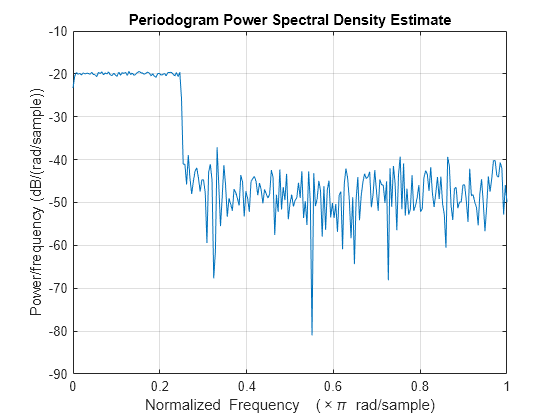
搬送周波数 の余弦を使用して信号の振幅変調を行います。変調された信号のパワーが元の信号のパワーと等しくなるように で乗算します。PSD を推定します。
wc = pi/2;
x1 = x.*cos(wc*n)*sqrt(2);
periodogram(x1)
legend("Modulated")
SSB 振幅変調では信号の帯域幅が半減します。SSB 振幅変調を実行するには、最初に信号のヒルベルト変換を計算しなければなりません。続いて、同じ搬送周波数 を持つ正弦を使用して、前と同様に信号の振幅変調を行い、それを前の信号に付加します。
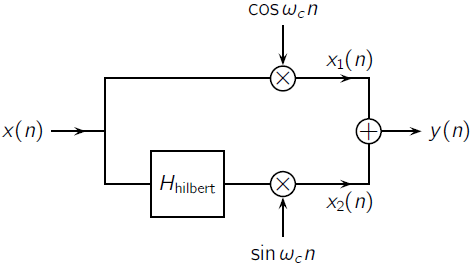
関数 designfilt を使用してヒルベルト変換器を設計します。フィルター次数 64 と遷移幅 0.1 を指定します。信号をフィルター処理します。
Hhilbert = designfilt("hilbertfir",FilterOrder=64, ... TransitionWidth=0.1); xh = filter(Hhilbert,x);
関数 grpdelay を使用して、フィルターによって生じる遅延 gd を測定します。フィルター処理した信号の最初の gd 点を破棄し、末尾をゼロでパディングすることで遅延を補正します。結果を振幅変調して元の信号に付加します。PSD を比較します。
gd = mean(grpdelay(Hhilbert)); xh = xh(gd+1:end); eh = zeros(size(x)); eh(1:length(xh)) = xh; x2 = eh.*sin(wc*n)*sqrt(2); y = x1+x2; periodogram([x1;y]') legend(["Modulated" "SSB"])
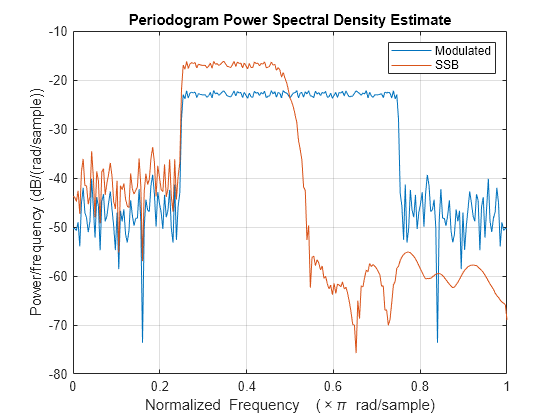
信号をダウンコンバートし、PSD を推定します。
ym = y.*cos(wc*n)*sqrt(2);
periodogram(ym)
legend("Downconverted")
変調された信号をローパス フィルター処理し、元の信号を復元します。カットオフ周波数 の 64 次 FIR ローパス フィルターを指定します。フィルターによって生じた遅延を補正します。
d = designfilt('lowpassfir',FilterOrder=64, ... CutoffFrequency=0.5); dem = filter(d,ym); gd = mean(grpdelay(d)); dem = dem(gd+1:end); dm = zeros(size(x)); dm(1:length(dem)) = dem;
フィルター処理された信号の PSD を推定し、元の信号の PSD と比較します。
periodogram([x;dm]') legend(["Original" "Recovered"])
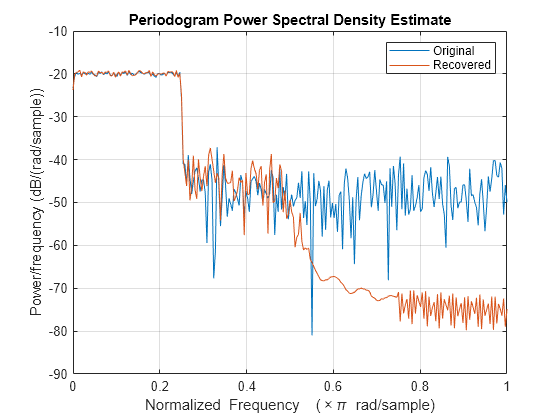
関数 snr を使用して 2 つの信号の S/N 比を比較します。時間領域に 2 つの信号をプロットします。
snrOrig = snr(x,noise)
snrOrig = 20.0259
snrRecv = snr(dm,noise)
snrRecv = 20.1373
plot(n,[x;dm]') legend(["Original" "Recovered"]) axis tight
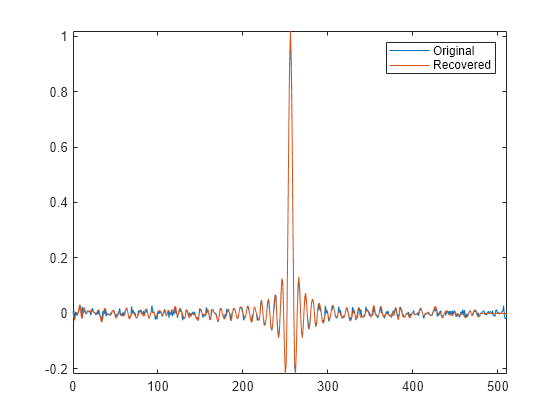
参考文献
Buck, John R., Michael M. Daniel, and Andrew C. Singer. Computer Explorations in Signals and Systems Using MATLAB. 2nd Edition. Upper Saddle River, NJ: Prentice Hall, 2002.
参考
designfilt | periodogram | snr